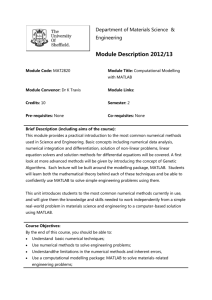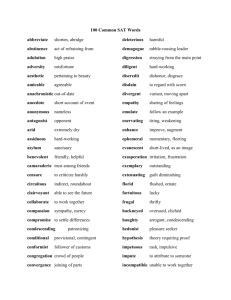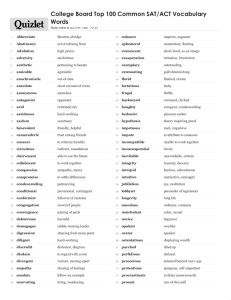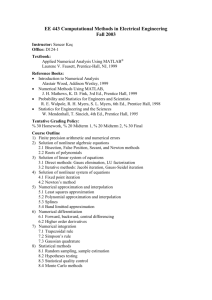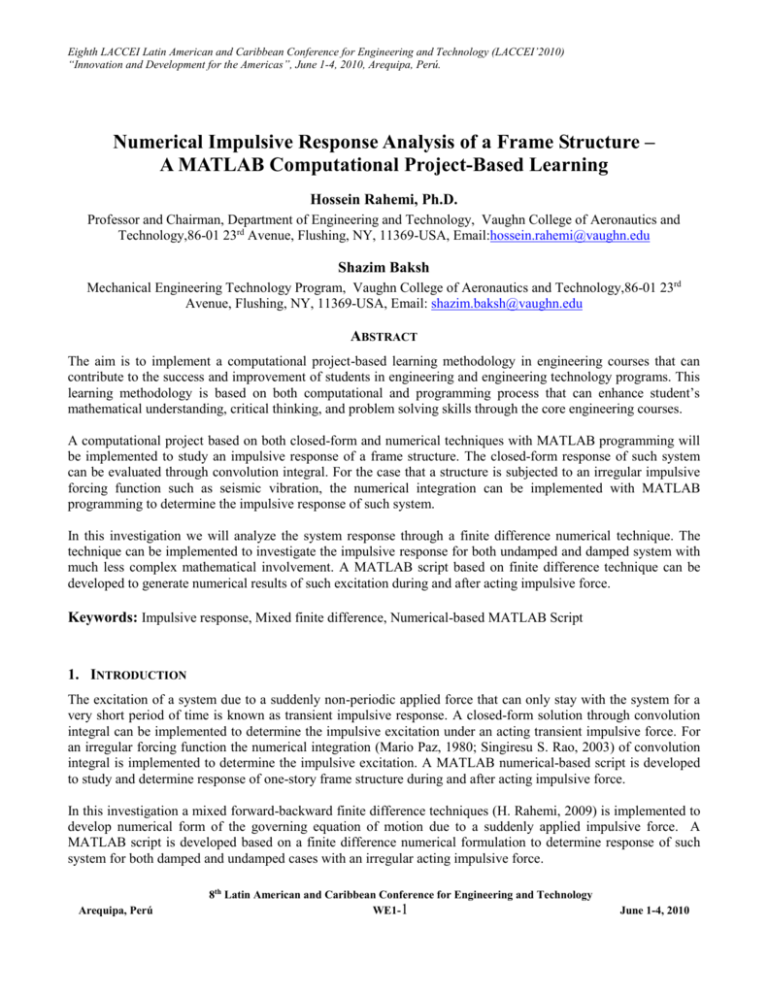
Eighth LACCEI Latin American and Caribbean Conference for Engineering and Technology (LACCEI’2010)
“Innovation and Development for the Americas”, June 1-4, 2010, Arequipa, Perú.
Numerical Impulsive Response Analysis of a Frame Structure –
A MATLAB Computational Project-Based Learning
Hossein Rahemi, Ph.D.
Professor and Chairman, Department of Engineering and Technology, Vaughn College of Aeronautics and
Technology,86-01 23rd Avenue, Flushing, NY, 11369-USA, Email:hossein.rahemi@vaughn.edu
Shazim Baksh
Mechanical Engineering Technology Program, Vaughn College of Aeronautics and Technology,86-01 23rd
Avenue, Flushing, NY, 11369-USA, Email: shazim.baksh@vaughn.edu
ABSTRACT
The aim is to implement a computational project-based learning methodology in engineering courses that can
contribute to the success and improvement of students in engineering and engineering technology programs. This
learning methodology is based on both computational and programming process that can enhance student’s
mathematical understanding, critical thinking, and problem solving skills through the core engineering courses.
A computational project based on both closed-form and numerical techniques with MATLAB programming will
be implemented to study an impulsive response of a frame structure. The closed-form response of such system
can be evaluated through convolution integral. For the case that a structure is subjected to an irregular impulsive
forcing function such as seismic vibration, the numerical integration can be implemented with MATLAB
programming to determine the impulsive response of such system.
In this investigation we will analyze the system response through a finite difference numerical technique. The
technique can be implemented to investigate the impulsive response for both undamped and damped system with
much less complex mathematical involvement. A MATLAB script based on finite difference technique can be
developed to generate numerical results of such excitation during and after acting impulsive force.
Keywords: Impulsive response, Mixed finite difference, Numerical-based MATLAB Script
1. INTRODUCTION
The excitation of a system due to a suddenly non-periodic applied force that can only stay with the system for a
very short period of time is known as transient impulsive response. A closed-form solution through convolution
integral can be implemented to determine the impulsive excitation under an acting transient impulsive force. For
an irregular forcing function the numerical integration (Mario Paz, 1980; Singiresu S. Rao, 2003) of convolution
integral is implemented to determine the impulsive excitation. A MATLAB numerical-based script is developed
to study and determine response of one-story frame structure during and after acting impulsive force.
In this investigation a mixed forward-backward finite difference techniques (H. Rahemi, 2009) is implemented to
develop numerical form of the governing equation of motion due to a suddenly applied impulsive force. A
MATLAB script is developed based on a finite difference numerical formulation to determine response of such
system for both damped and undamped cases with an irregular acting impulsive force.
Arequipa, Perú
8th Latin American and Caribbean Conference for Engineering and Technology
WE1-1
June 1-4, 2010
Eighth LACCEI Latin American and Caribbean Conference for Engineering and Technology (LACCEI’2010)
“Innovation and Development for the Americas”, June 1-4, 2010, Arequipa, Perú.
However any numerical solution involved with error, through Taylor’s series, using both forward and backward
finite difference, the truncation error been estimated to be in order of step size. To increase the accuracy of the
numerical results, one should consider the step size as small as possible.
In this investigation we will study two cases of impulsive vibration; (1) Undamped System, (2) Damped System.
For the case of undamped system the results by finite difference technique will be compared by the numerical
integration of convolution integral.
2. COMPUTATIONAL PROJECT-BASED LEARNING MODEL
The aim is to implement a methodology based on computational project-based learning model to enhance
student’s learning objectives (analytical, numerical, critical thinking, and problem solving skills) through the
engineering core courses (H. Rahemi, 2009). Figure 1 is a graphical model of computational project-based
learning.
Figure 1: Computational Project-Based Learning Model
The behavior of many engineering systems (deformation, vibration, heat transfer, and others) can be identified by
the solution of the governing equation of the body (H. Rahemi, 2007). The focus of this study is given to both
closed-form and numerical solution using MATLAB programming. In this investigation, we will analyze the
impulsive response of one-story frame structure by both closed-form numerical integration and a mixed (forwardbackward) finite difference numerical technique.
3. IMPULSIVE RESPONSE ANALYSIS OF ONE-STORY FRAME STRUCTURE
In this investigation we will study a problem related to the impulsive vibration analysis of a one-story structure
with four beam columns (W8x24) supporting structure. For this problem both closed-form numerical integration
and numerical finite difference methods can be employed to determine the response of the structure. A MATLAB
script can be developed to generate results and identify the vibration behavior of structure under an acting
impulsive force as shown in Fig. 2.
Arequipa, Perú
8th Latin American and Caribbean Conference for Engineering and Technology
WE1-2
June 1-4, 2010
Eighth LACCEI Latin American and Caribbean Conference for Engineering and Technology (LACCEI’2010)
“Innovation and Development for the Americas”, June 1-4, 2010, Arequipa, Perú.
Knowing that columns are rigid to the flour slab (Fig. 2C), the total spring rate (KT) can be expressed as follow
KT 4 K
48EI
L3
(1)
Let’s consider W8x24 steel beam for the column
With I = 82.8 in4 and E = 30e6 psi, the spring
Rate for four columns can be evaluated as
4(12)(30e6)(82.8)
10,000 lb / in
(19 x12) 3
kT
The weight of flour slab with all other dead loads can be considered as 38.7 kips, hence, the mass can be
calculated as
m
W
38,700 lb
lb s 2
100
g 386.4 in / s 2
in
3.1 NUMERICAL INTEGRATION
The impulsive response based on convolution integral (Mario Paz, 1980) for an undamped system can be
expressed as
x(t )
1
m n
t
F
0
( )
sin n (t )d
(2)
Above can also be expressed as
x(t )
1
m n
sin( t) F
t
n
0
( )
t
cos( n )d cos( n t ) F( ) sin( n )d
0
(3)
The numerical integration of an impulsive response based on a piecewise linear forcing function has been studied
by many researchers (Mario Paz, 1980; Singiresu S. Rao, 2003). Here, we will develop a MATLAB script based
on such numerical integration to investigate the impulsive response behavior of one-story fame structure. Fig.3, is
a representation of a piecewise liner forcing relationship between time ti and ti+1, that is
Arequipa, Perú
8th Latin American and Caribbean Conference for Engineering and Technology
WE1-3
June 1-4, 2010
Eighth LACCEI Latin American and Caribbean Conference for Engineering and Technology (LACCEI’2010)
“Innovation and Development for the Americas”, June 1-4, 2010, Arequipa, Perú.
F
( t i )
t
F( ) F(ti )
(4)
Hence, the numerical form of response (Mario Paz, 1980) can be expressed as
x ( t 1 i )
1
m n
sin( n t i 1 ) M (t i 1 ) cos( n t i 1 ) N (t i 1 )
where M (t i 1 ) M (t i )
t i 1
ti
(5)
F( ) cos( n )d
F [sin( n t i 1 ) sin( n t i )]
M (t i 1 ) M (t i ) F (t i ) t i
t
n
F
2 cos( n t i 1 ) cos( n t i ) n t i 1 sin( n t i 1 ) t i sin( n t i )
n t
ti 1
and N (ti 1 ) N (ti ) F( ) sin( n )d
ti
F [cos( n t i ) cos( n t i 1 )]
N (t i 1 ) N (t i ) F (t i ) t i
t
n
F
2 sin( n t i 1 ) sin( n t i ) n t i 1 cos( n t i 1 ) t i cos( n t i )
n t
A MATLAB script based on above numerical integration is written to generate the numerical response of a
system under impulsive force. In this study, the response behavior of a one-story frame structure based on an
impulsive forcing function as shown in figure 4 has been investigated.
F( ) F0
for TD1 TD2
TD3
F( ) Fo
TD3 TD1
F( ) 0 for TD3
Arequipa, Perú
for TD2 TD3
8th Latin American and Caribbean Conference for Engineering and Technology
WE1-4
June 1-4, 2010
Eighth LACCEI Latin American and Caribbean Conference for Engineering and Technology (LACCEI’2010)
“Innovation and Development for the Americas”, June 1-4, 2010, Arequipa, Perú.
MATLAB Program - Numerical Integration
% Numerical Analysis of Convolution Integral
% Impulsive Vibration Analysis of an Undamped System
% For an acting rectangular force up to time TD2
% and a Triangular decreasing force up to time TD3
% h must be ≤ TD/10 to generate smooth response graph
ti = input('Initial time ti=');
tf = input('Final time tf=');
TD = input('Time Duration of Impulsive
force Row Matrix TD=');
h = input('Time step size h=');
m = input('Mass, m =');
k = input ('Spring Cons. k = ');
Fo = input ('Force, Fo =');
wn = (k/m)^.5;
n = 1+((tf-ti)/h);
t=zeros(n,1); x=zeros(n,1);
t(1)=ti; M(1)=0; N(1)=0;
j=1;
while (1)
t(j+1)=t(j)+h;
if t(j)<= TD(1,2);
F(j)=Fo;
F(j+1)=F(j);
The conditional loop can be
elseif (t(j)<=TD(1,3) & t(j)>=TD(1,2))
adjusted to consider the effect
F(j) =(Fo/(TD(1,3)-TD(1,2)))*(TD(1,3)-t(j));
F(j+1)=((TD(1,3)-t(j+1))/(TD(1,3)-t(j)))*F(j); of a specific applied
else
impulsive force.
F(j) =0;
F(j+1)=F(j);
end
M(j+1)=M(j)+(F(j)-t(j)*((F(j+1)-F(j))/h))*(1/wn)*(sin(wn*t(j+1))sin(wn*t(j)))+((F(j+1)-F(j))/((wn^2)*h))*(cos(wn*t(j+1))cos(wn*t(j))+wn*(t(j+1)*sin(wn*t(j+1))-t(j)*sin(wn*t(j))));
N(j+1)=N(j)+(F(j)-t(j)*((F(j+1)-F(j))/h))*(1/wn)*(cos(wn*t(j))cos(wn*t(j+1)))+((F(j+1)-F(j))/((wn^2)*h))*(sin(wn*t(j+1))sin(wn*t(j))-wn*(t(j+1)*cos(wn*t(j+1))-t(j)*cos(wn*t(j))));
x(j+1) =(M(j+1)*sin(wn*t(j+1))-N(j+1)*cos(wn*t(j+1)))/(m*wn);
if t(j+1) >= tf, break, end
j=j+1;
end
disp ('
Time
Response
')
disp ([t x ])
plot(t,x)
Upon execution the results can be generated as shown
Initial time ti=0
Final time tf=1
Time step size h=0.01
Time Duration of Impulsive force Row Matrix TD=[0 0.2 0.4]
Mass, m =100
Spring Cons. k = 100000
Force, Fo =80000
Arequipa, Perú
8th Latin American and Caribbean Conference for Engineering and Technology
WE1-5
June 1-4, 2010
Eighth LACCEI Latin American and Caribbean Conference for Engineering and Technology (LACCEI’2010)
“Innovation and Development for the Americas”, June 1-4, 2010, Arequipa, Perú.
3.2 FINITE DIFFERENCE NUMERICAL ANALAYSIS
The governing equation of a system under an external force can be expressed as
d 2 x c dx k
1
x F(t )
2
m dt m
m
dt
(6)
For an acting impulsive force with various force functions, it is not feasible to determine the analytical solution.
However, a solution based on finite difference techniques can be implemented with MATLAB to determine
response of the system during and after acting impulsive force.
Above equation can also be expressed as
dV c
K
1
V x F(t )
dt m
m
m
(7)
Using forward divided difference, first derivative can be approximated as
dV V (t i 1 ) V (t i )
O(h)
dt
h
(8)
The first forward difference of the governing equation will provide velocity at time ti+1, that is
c
k
1
V(ti 1 ) F(ti ) V(ti ) x(ti ) h
m
m
m
(9)
The first backward difference of above equation will provide response at time ti+1, that is
c
k
1
x(ti 1 ) F(ti ) V( ti ) x( ti ) h 2 x(ti )
m
m
m
(10)
A general MATLAB program based on mixed difference (forward-backward) approximation of above finite
difference numerical formulations is developed to identify the vibration behavior of a damped and undamped
structure under an impulsive acting force.
MATLAB Program – Mixed (Forward-Backward) Finite Difference Technique
% Impulsive Vibration, Mix Finite Difference
% h must be very small in comparison to TD (h«TD/10)
ti = input('Initial ti:'); tf = input('final tf:');
h = input('step size h:'); xi = input('Initial xi:');
m = input('mass, m =');
c = input ('Damping Coef., c = ');
k = input ('Spring Cons. k = ');
Fo = input ('Force ampl., Fo =');
vi = input('Initial vi:');
TD = input('Time Duration of Impulsive force Row Matrix TD=');
n = 1+((tf-ti)/h);
t=zeros(n,1); x=zeros(n,1); v=zeros(n,1);
t(1) = ti; x(1) = xi; v(1) = vi;
j=1;
Arequipa, Perú
8th Latin American and Caribbean Conference for Engineering and Technology
WE1-6
June 1-4, 2010
Eighth LACCEI Latin American and Caribbean Conference for Engineering and Technology (LACCEI’2010)
“Innovation and Development for the Americas”, June 1-4, 2010, Arequipa, Perú.
while (1)
if t(j)<=TD(1,2);
F(j)=Fo;
elseif (t(j)<=TD(1,3) & t(j)>TD(1,2));
F(j)=((TD(1,3)-t(j))/(TD(1,3)-TD(1,2)))*Fo;
else
F(j)=0;
end
x(j+1) =((1/m)*F(j)- (k/m)*x(j)-(c/m)*v(j))*h^2 + v(j)*h + x(j);
v(j+1) = ((1/m)*F(j)-(k/m)*x(j)-(c/m)*v(j))*h + v(j);
t(j+1) = t(j)+h;
if t(j+1) >= tf, break, end
j=j+1;
end
disp ('
Time
Response velocity ')
disp ([t x v ])
plot(t,x)
Upon execution the results can be generated as shown
initial ti:0
final tf:1
step size h:0.002
Initial xi:0
mass, m =100
Damping Coef., c = 0
Spring Cons. k = 100000
Force ampl, Fo =80000
Initial vi:0
Time Duration of Impulsive force Row Matrix TD=[0 0.2 0.4]
For a time step size, h =TD/100, the results by finite difference technique (Table 2) in comparison to the results of
closed-form numerical integration (Table 1) produce an error of ± 1% (error in order of step size).
By considering the air damping effect, C= 50 lb-sec/in, upon execution of MATLAB program with the entree of
the following input data through command window, the impulsive vibration behavior can be identified for a
damped one-story frame structure, that is
Arequipa, Perú
8th Latin American and Caribbean Conference for Engineering and Technology
WE1-7
June 1-4, 2010
Eighth LACCEI Latin American and Caribbean Conference for Engineering and Technology (LACCEI’2010)
“Innovation and Development for the Americas”, June 1-4, 2010, Arequipa, Perú.
Initial ti:0
final tf:4
step size h:0.002
Initial xi:0
mass, m =100
Damping Coef., c = 50
Spring Cons. k = 100000
Force ampl, Fo =80000
Initial vi:0
Time Duration of Impulsive force Row Matrix TD=[0 0.2 0.4]
In this case due to damping effect, the impulsive response eventually dies out after several vibrating cycles.
4. CONCLUSION
As it can be observed, the numerical mix finite difference technique with a time step size, h ≤ TD/100, provide
results that are closely compatible with closed-form numerical integration approach. Development of finite
difference numerical technique for impulsive response analysis is much less time consuming without any complex
mathematical implication.
The MATLAB programming not only facilitates the computational process but also enable us to understand the
behavior of an engineering system based on a given mathematical model. In this investigation the MATLAB
programming enabled us to understand graphically the behavior of an impulsive response based on both the
closed-form numerical integration and finite difference numerical approach. The results showed that the accuracy
in finite difference numerical analysis can be achieved by selecting a proper step size, which is h ≤ (time duration
of acting force)/100.
The computational project-based learning model with MATLAB programming delivered learning objectives that
are required to motivate student’s mathematical, critical thinking, and problem solving skills. It can be observed
that MATLAB programming enable both researchers and students with a tool to understand different
mathematical techniques in analyzing and studying behavior of an engineering system.
Arequipa, Perú
8th Latin American and Caribbean Conference for Engineering and Technology
WE1-8
June 1-4, 2010
Eighth LACCEI Latin American and Caribbean Conference for Engineering and Technology (LACCEI’2010)
“Innovation and Development for the Americas”, June 1-4, 2010, Arequipa, Perú.
The presented analysis is based on an acting impulsive force on the structure. However, due to seismic ground
excitation, a future study will consider an impulsive behavior of one-story frame structure based on earthquake
ground excitation.
REFERENCES
Mario Paz, “Structural dynamics, theory and computation,” Van Nostrand Reinhold Company Inc, 1980
Singiresu S. Rao, “Mechanical Vibration,” 4th edition, Pearson prentice Hall, N.J., 2003.
Hossein Rahemi, “A Finite Difference and Finite Element Numerical Approach with MATLAB” 2nd
draft, Vaughn College Book Store, New York, 2009
Hossein Rahemi, “Deterministic Thermal Fracture Life Analysis of a Visco-elastic Cylinder” Paper presented
at fifth LACCEI International Latin American and Caribbean Conference for Engineering and
Technology, May 29 - June 01 2007, Tampico, México
Hossein Rahemi and Paul LaVergne, “Engineering Analysis with MATLAB programming-An approach to
enhance teaching and learning effectiveness” Paper presented at seventh LACCEI International Latin American
and Caribbean Conference for Engineering and Technology, June 02-05, 2009, San Cristobal, Venezuela
AUTHORIZATION AND DISCLAIMER
Authors authorize LACCEI to publish the paper in the conference proceedings. Neither LACCEI nor the
editors are responsible either for the content or for the implications of what is expressed in the paper.
Arequipa, Perú
8th Latin American and Caribbean Conference for Engineering and Technology
WE1-9
June 1-4, 2010



